ISSN ONLINE(2319-8753)PRINT(2347-6710)
ISSN ONLINE(2319-8753)PRINT(2347-6710)
Saurabh Chhabra1, Deepak Gupta2, Parveen Yadav3
|
| Related article at Pubmed, Scholar Google |
Visit for more related articles at International Journal of Innovative Research in Science, Engineering and Technology
Wire Electric discharge machine is a specialized thermal machining process capable of accurately machining parts with varying hardness and complex shapes. The material P-21 used in the present work study finds out the application as mould steel. The main aim of this investigation is to optimize the various process parameters of WEDM for single response characteristics using L18 orthogonal array to find out the performance characteristics from desired value. The present work was carried out on P-21 mould steel as work piece and zinc coated brass wire as tool electrode. Response characteristics are cutting speed and surface roughness. Three trial experiments were conducted and the average is chosen as the particular experimental condition. Experiment were performed by using different variables like input current, pulse-on, pulse-off, wire feed and wire tension. In the end confirmation experiment is carried out to validate the effectiveness of proposed optimal condition
Keywords |
| P-21, WEDM, L18 orthogonal array, S/N ratio, ANOVA |
I. INTRODUCTION |
| WEDM is a metal removing machine in which the electrode used is the continuous moving wire of Copper (Cu) and Brass. This is fed into the work-piece from the supply pool to take-up-pool. This continuous moving wire does not come in contact with the conductive work material. The material is eroded from the work-piece by discrete spark between the work-piece and electrode and these are separated by dielectric fluid. The gap between the work-piece and electrode is usually upto 0.0025-0.015mm and is maintained with the help of computer control WEDM. The important step is the selection of process parameter if improper process parameter are selected then it may result in problem i.e wire breakage, short circuiting of wire. No of studies has been carried out on various responses like material removal rate, surface roughness, cutting speed which depend upon various parameters like pulse-on, pulse-off, input current and many more. |
| WEDM is a metal removing machine in which the electrode used is the continuous moving wire of Copper (Cu) and Brass. This is fed into the work-piece from the supply pool to take-up-pool. This continuous moving wire does not come in contact with the conductive work material. The material is eroded from the work-piece by discrete spark between the work-piece and electrode and these are separated by dielectric fluid. The gap between the work-piece and electrode is usually upto 0.0025-0.015mm and is maintained with the help of computer control WEDM. The important step is the selection of process parameter if improper process parameter are selected then it may result in problem i.e wire breakage, short circuiting of wire. No of studies has been carried out on various responses like material removal rate, surface roughness, cutting speed which depend upon various parameters like pulse-on, pulse-off, input current and many more. |
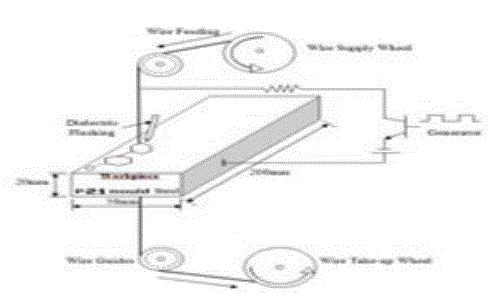 |
II. EXPERIMENTAL SET-UP AND SELECTION OF PROCESS PARAMETERS |
| The pulse generator capacity of the machine is 40A. The pulse generator supplies the electrical energy to the spark gap in the form of pulses. The machine tool unit comprises of a main worktable (called X-Y table) by which the work piece is clamped on auxiliary table (called U-V table) and wire drive mechanism. Figure 2. shows the stepwise procedure for Taguchi experimental design and analysis. Figure 3. shows the experiments are carried out in CNC sprint cut wire EDM of Electronic a Machine tool ltd. |
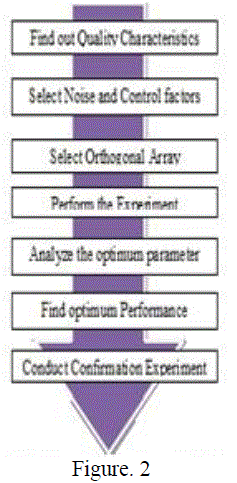 |
| Work piece Electrode: - The work piece material used in this investigation was steel P-21 Mould steel. Composition of P-21 Mould steel is C= 0.18-0.22% , Mn= 0.20-0.40% , Si ≤0.030% ,Cr= 0.50-0.30%, Ni=3.90-4.25%, Si= 0.20- 0.40%, P≤ 0.030, V= 0.15-0.25, Al = 1.05-1.25. A P-21 die Mould steel plate of size 200x50x20 (l x b x w) is used. |
| Tool Electrode: Zinc coated copper wire having dia of 0.25mm is used in the present investigation as the electrode. Zinc coated Copper wire electrode can conduct high current as compare to simple copper wire. |
Selection of Process Parameters and their Ranges: |
| In order to obtain high cutting speed, accurate dimension, better quality of surface roughness and the Good Material removal rate can be obtained by WEDM process. The optimal level of WEDM process parameters need to be determined. Based on the critical review of literature, process variables of the WEDM are selected according to transient state. |
| The process parameters selected for this study are as following: |
| a. Current. |
| b. Pulse- ON time. |
| c. Pulse-OFF time. |
| d. Wire Speed |
| e. Wire Tension |
| In Sprint-cut WEDM, the value of current ranges b/w 10 to 230A, Pulse-ON time b/w 110 to 131, Pulse-OFF varies b/w 0-63, Wire speed 1-15m/min and Wire tension ranges between1 to 15N. |
III. SELECTION OF ORTHOGONAL ARRAY (OA) AND PARAMETER ASSIGNMENT |
| \Before selecting a particular OA to be used as a matrix for conducting the experiments, the following two points are first considered: |
| 1. The number of parameters and interactions of interest. |
| 2. The number of levels for the parameters of interest. |
| Degree of freedom (DOF) associated with each factor is equal to no. of level -1. Therefore, total degree of freedom for the five factors is (5+2+2+2+2) 11. As per Taguchi’s method, the total DOF of selected OA must be greater than or equal to the total DOF required for the experiment. So, L18 OA having 17 (=18-1) degree of freedom is selected for the present analysis. The experiments are conducted at each trial conditions as given in table 2. For each trial, the experiments is repeated by three times. |
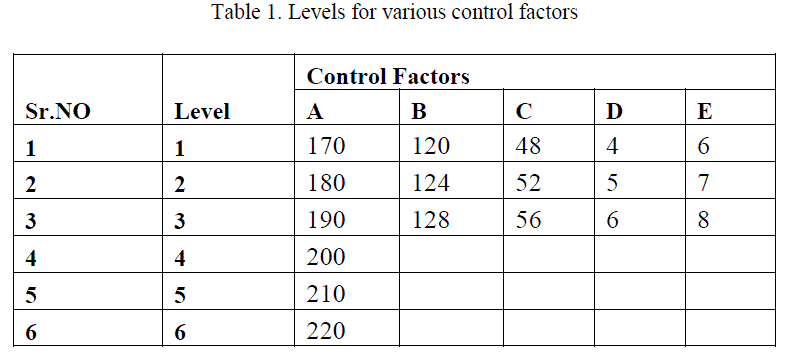 |
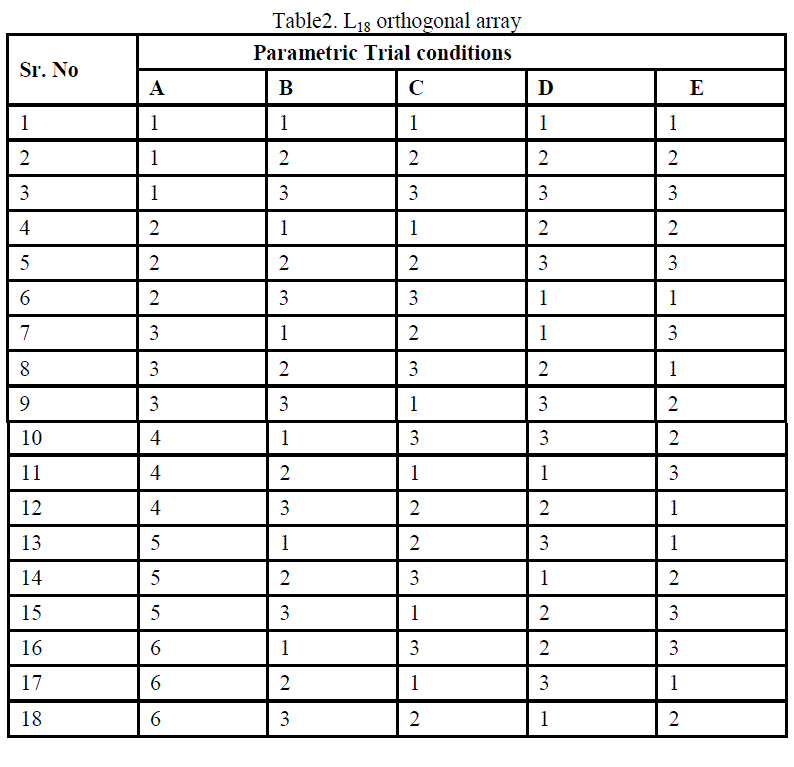 |
IV. RESULT AND DISCUSSION |
| In this section, we are discussing the effect of WEDM process parameters( peak current, pulse on time, pulse off time, current, wire speed and wire tension) on the basis of response characteristics(cutting speed and surface roughness). The average value of response characteristics, mean data and S/N ratio for each parameter, at all levels, is calculated from table 3. These effects are plotted by using MINITAB 15 SOFTWARE. |
Effect Of Parameters On Cutting Speed |
| Average value of Cutting speed calculated from raw data is 3.71 mm/min. It is clear from the S/N plots. That the maximum S/N ratio occurs correspond to A6,B3,C1,D1,E3.Therefore, the optimum value will correspond to these factors but only the significant factor would be chosen. This factor will be chosen from the ANOVA table. |
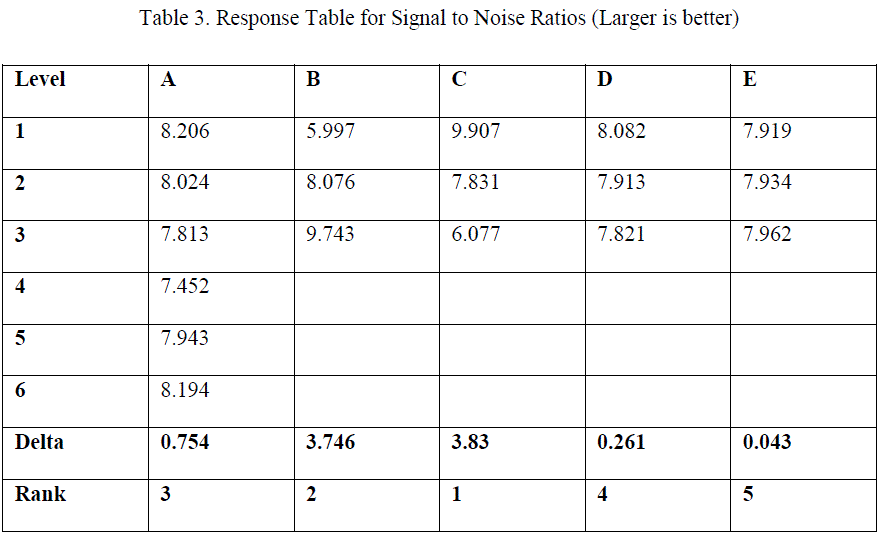 |
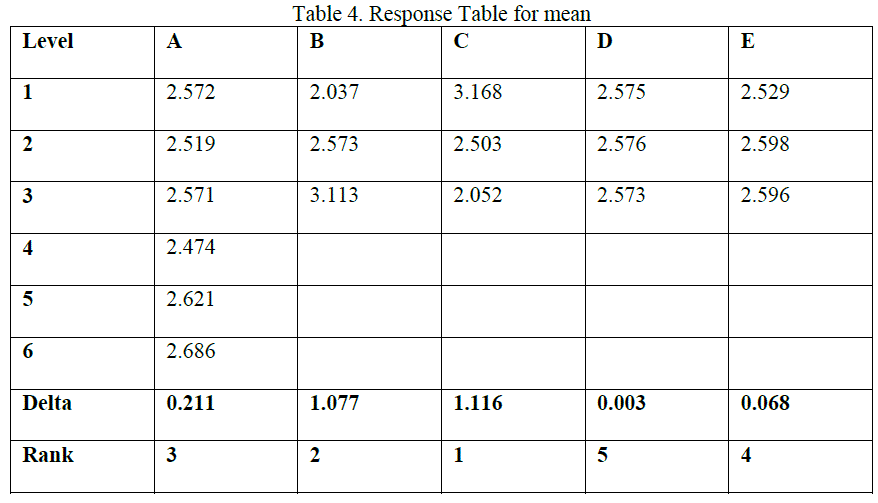 |
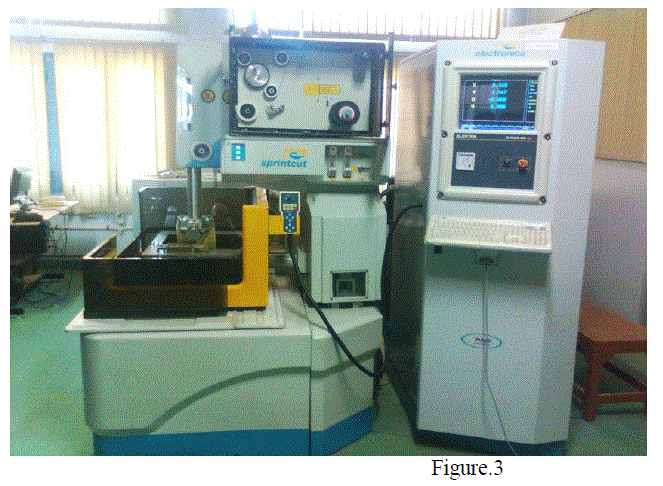 |
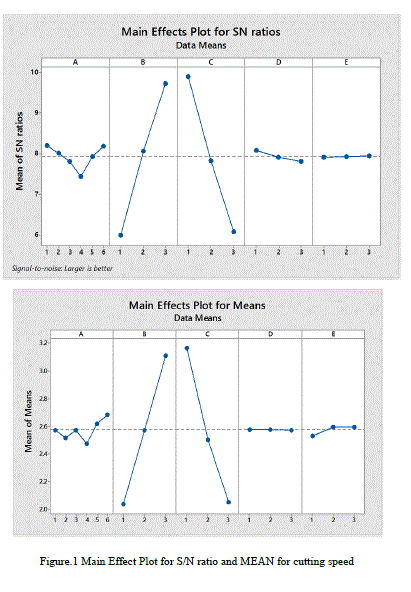 |
Effect of Parameters On Surface Roughness |
| Surface roughness is a key factor in die making and depends upon the energy drop across the electrodes. Surface roughness is a “smaller is better” type characteristics. So, the optimum value of surface roughness should be low so that depth of recast layer remains minimum or equal to zero. Average value of surface roughness is 2.83μm. Main effects of each parameter are calculated from response table 5 and 6 as shown in fig 2. These effects are plotted by using MINITAB 15. |
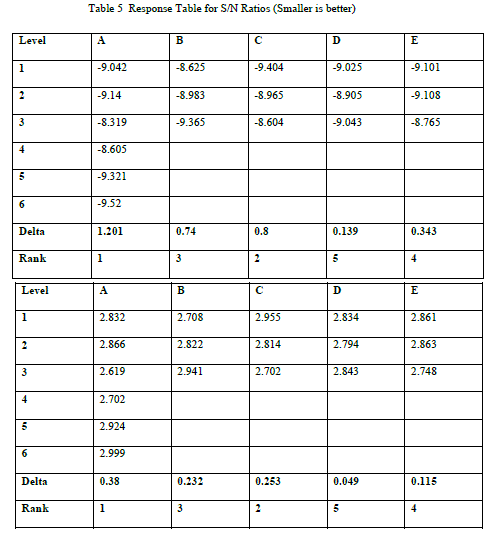 |
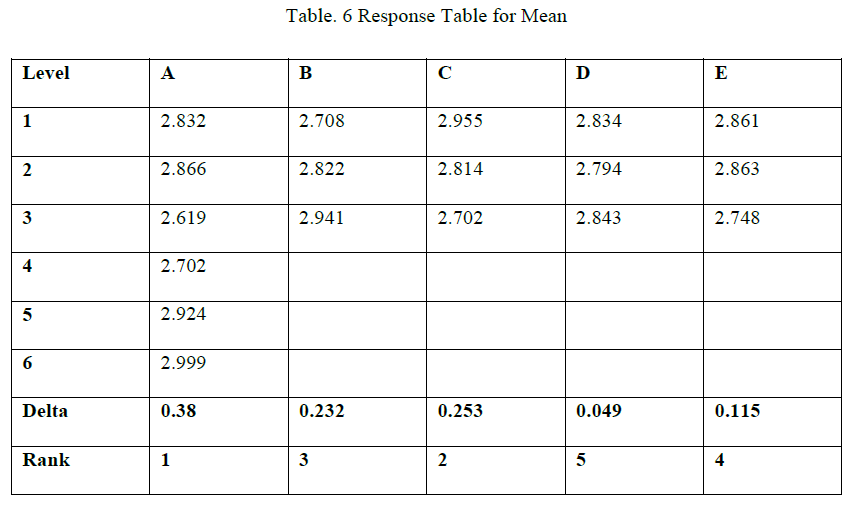 |
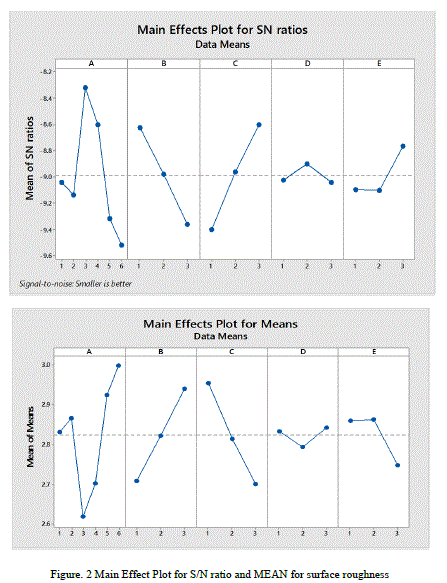 |
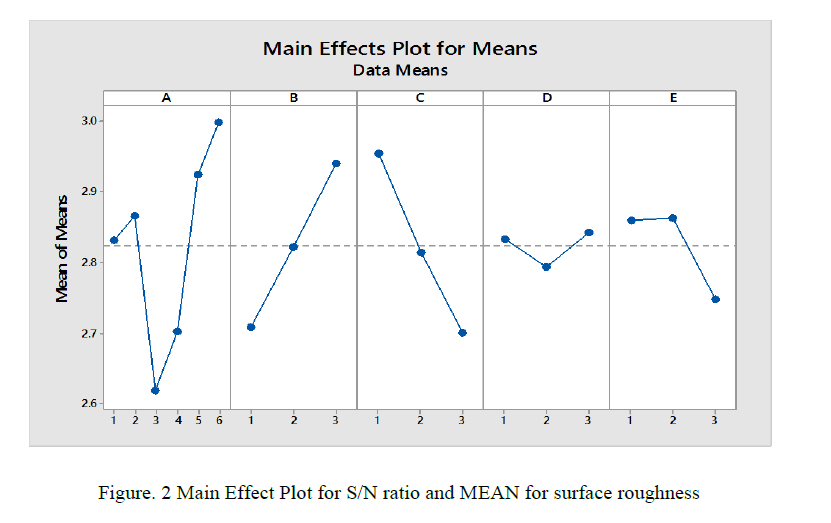 |
Confirmation Experiment: |
| It is conducted for the cutting speed, die width and for surface roughness. The experimental value obtained at the optimal setting of parameter is: |
| Cutting speed = 3.56 mm/min |
| Surface roughness = 3.13μm. |
V. CONCLUSION |
| On the basis of above studied experiments, it can be safely concluding that:- . |
| • Cutting Speed is affected by Pulse-on and Pulse-off time |
| • Surface roughness does not have any significant factor |
References |
|